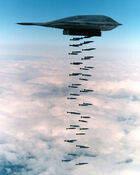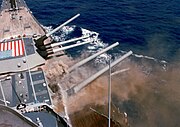
Small arms live fire training, simulating advancing upon an enemy compound at Camp Buehring, Kuwait, 2009.
A live fire exercise or LFX is any exercise in which a realistic scenario for the use of specific equipment is simulated. In the popular lexicon this is applied primarily to tests of weapons or weapon systems that are associated with the various branches of a nation's armed forces, although the term can be applied to the civilian arena as well.
Armed services[]
Armed services usually use live fire exercises as an opportunity to use real ammunition in a realistically created combat situation. The area in which these tests are conducted will be devoid of people to avoid casualties, and will likely be owned by the government which authorized the test. Most live fire tests are conducted either against derelict equipment, such as tanks and ships, or against remotely controlled drones.
The purpose of this type of exercise is twofold: First, it offers recruits the chance to get accustomed to their weapons so that they will know how to properly operate them. Secondly, this provides soldiers with an opportunity to fire live ammunition without having to worry about an actual enemy returning fire. This allows soldiers to get reacquainted with the feel and time of actually using and expending ammunition rather than simply simulating the experience. Live fire exercises of this type can be observed either by remotely controlled cameras or by long range telescopic devices, such as binoculars.
Army[]

A Canadian Army Mercedes-Benz G-Class wagon in a live-fire exercise with Canadian soldier firing the mounted C6 GPMG.
An army, being the main branch responsible for land combat, is perhaps the best known group that conducts live fire exercises. Most live fire exercises occur within the military base where the units conducting the exercise are located. In some cases one installation will host units from another for a larger live fire exercise. Equipment tested under these circumstances range from small arms and assault rifle fire all the way up to missile systems and artillery fire. In the case of small arms, the tests are usually proficiency based and aimed at ensuring a soldier can fire their assigned weapons. In the case of the latter, missile systems may be test-fired at remotely controlled drones to simulate a situation in which enemy missiles or aircraft are launched at allied or friendly forces, while artillery units can take the opportunity to test new shells or to fire under adverse weather conditions for a chance to see how the artillery pieces will perform.
Marine forces[]

U.S. Marines conduct a live fire exercise with an M1A1 Abrams Tank in Iraq.
For the most part marine corps live fire exercises are similar to the army's live fire exercises. One notable difference stems from the amphibious nature of a marine force's duty, which can lead the force to incorporate amphibious assault ships when they conduct live fire exercises.
Air forces[]

A B-2 Spirit dropping Mk.82 bombs in a 1994 training exercise off Pt. Mugu in the Pacific Ocean.
An Air force, due to its nature, usually limits live fire exercises to the air, although bombing exercises can be conducted as well.
During live fire exercises dealing with air-to-air combat remotely controlled drones are frequently used to simulate enemy aircraft. In modern times the drones are fired on by planes loaded with some type of air-to-air missile, with the objective of the exercise being to destroy the drone. These test are usually done to ensure that guidance packages within the missiles will work, although they can be done to test other factors such as a missiles' susceptibility to jamming or to see if a new type of dodging technique will work against the missiles fired.
Live fire exercises involving air to surface work are usually centered around precision-guided munitions. In some cases tests involving bombs will make use of derelict buildings or, even more frequently, vehicles. Live fire bombing exercises are usually conducted with precision guided munitions to ensure that they work correctly, but are also used to test new and experimental weapons to ensure that they work as they were originally designed to. These test are usually monitored by chase planes and by cameras to determine if everything worked as it was originally intended to.
Live fire exercises may also be conducted against planes for the purpose of testing a plane's susceptibility to SAM sites, or as a means to test a plane's stealth features.
[]

U.S. Arleigh Burke-class destroyers fire anti-missile missiles during a live fire exercise.
Naval live fire exercises may use anti-ship missiles and torpedoes, although tests involving air-to-air and air-to-surface missile, guns and bombs are not uncommon. Navies conduct live fire exercises to test elements of an integrated defense system such as the US Aegis; namely its ability to track and destroy enemy anti-ship missiles. Tests can also include an integrated defense system’s compatibility to fire new missiles or newer versions of the same missile. Live fire tests are also conducted with a CIWS system, which is designed as the last line of defense for a ship. Surface ships also frequently testfire the various guns kept and maintained aboard the vessel, these can range from side arms and rifles up to the 16" guns of the mothballed US Iowa-class battleships. This is done to maintain the skill and knowledge needed to operate the weapon. In the case of aircraft carriers, the pilots assigned to the carrier may conduct air-to-air and air-to-surface missile exercises similar to those of the air force; additionally, these pilots may also conduct live fire exercises against derelict ships. Recent aircraft carriers have incorporated missile launching systems, and have taken part in live fire exercises involving missiles. For submarines, both fast attack and ballistic missile (or "boomers"), live fire tests may include firing sea-to-land missiles at targets on shore or launching dummy ballistic missiles; however, the most frequent live fire exercises conducted by submarines involve firing torpedoes at a target. The best known tests of torpedoes are those conducted against a derelict ship, typically on ships from a Navy's own mothball fleet that has become too old or obsolete to warrant maintaining. The purpose of these tests is to ensure that the torpedo will work under combat conditions, and such tests can be used to determine whether or not noisemakers or other decoys will have any effect against the unit when launched.
Use against training soldiers[]
Some forces, especially in more authoritarian societies[citation needed], have also been known to use live ammunition against their own forces in military exercises,[citation needed] to ensure that the soldiers 'take their training seriously' and get accustomed to being shot at before facing actual enemies. This kind of fire is usually not intended to kill anyone, though practices such as firing into the ground close to a soldier going through an obstacle course pose obvious risks.
The Soviet Union, just after Joseph Stalin died in 1954, conducted a live nuclear test, during exercises at the Totskoye range, against soldiers at a distance believed to be safe when in trenches. Any immediate deaths can't be proven today, but Russian human rights activists assert that the long aftermath death toll is in the thousands.[citation needed]
A similar live nuclear test was performed by the USMC Marine Corps Test Unit and US Army Armored Task Force "Razor" during exercise Teapot (Desert Rock VI) at the Nevada Test Site in 1955.
In some fictional scenarios, such as the training of the soldiers in Robert A. Heinlein's Starship Troopers, a small fraction of the ammunition shot at the soldiers during exercises is real, and the shots are fully aimed. This again is intended to encourage soldiers to take their training seriously, knowing that failure is possibly deadly.
The British SAS and Royal Marines are also known to use live rounds, for the former during the jungle phase of training, and the latter using live rounds in their final exercise.[citation needed] The SAS also use live fire in regular close quarter combat training.[citation needed]
Non-military[]

Cannon in a Civil War re-enactment: The large amounts of gunpowder used often affected visibility significantly. Gunners hope for a strong wind that will allow them to continue to see their target.
Weapons tests are not usually conducted by civilian agencies; however, some civilian groups do conduct live fire tests of equipment to ensure that they work properly or to test new methods. Examples here would include law enforcement agencies (shooting ranges) and controlled explosions by demolition experts . Sometimes historical reenactments, such as those done for the Battle of Gettysburg, will include live fire demonstrations so the general public can observe historical equipment in action.[citation needed]
Other types[]

Testing of the LG-118A Peacekeeper re-entry vehicles, all eight fired from only one missile. Each line represents the path of a warhead which, were it live, would detonate with the explosive power of twenty-five Hiroshima-style weapons.
Other types of live fire exercises include various nuclear tests conducted by the world's nuclear powers. Also in this group are the live fire tests of new and exotic weaponry like the Massive Ordnance Air Blast bomb, or "Mother of all Bombs". Also numbered among the unique weapons tests are test fires of intercontinental ballistic missiles (ICBM) and multiple independently targetable reentry vehicles. Recently, a new addition was made to this area when live fire tests began of the U.S. Strategic Defense Initiative, nicknamed "Star Wars". These live fire tests are aimed at intercepting incoming enemy ballistic missiles before they can detonate over their designated target.
Dangers[]

Inspection for safety before a live-fire exercise

On 19 April 1989, USS Iowa's #2 turret exploded for undetermined reasons during a routine live fire training exercise. Forty-seven sailors died as a result of the blast.
One cannot address live fire exercises without addressing their potential dangers. In any situation in which hazardous materials are involved there exists the potential for a mishap to occur, and when these mishaps occur the results can be as spectacular as they are deadly. All forms of ordnance contain some type of explosive charge to launch and, in most cases, detonate, a weapon. If these charges are inappropriately stored or handled the result can be serious injury or death to the person and anyone in the immediate vicinity. Other dangers include faulty guidance and sensory information, which can cause guided ordnance to inadvertently target friendly or neutral units. Advances in technology have helped to reduce, and in some cases eliminate, problems with these materials; nonetheless, extreme care must be given when using or implementing them. For example, the handling of gunpowder demands the use of gloves and an area free of static electricity and other potential sparks which could ignite the powder.
References[]
| ||||||||
The original article can be found at Live fire exercise and the edit history here.